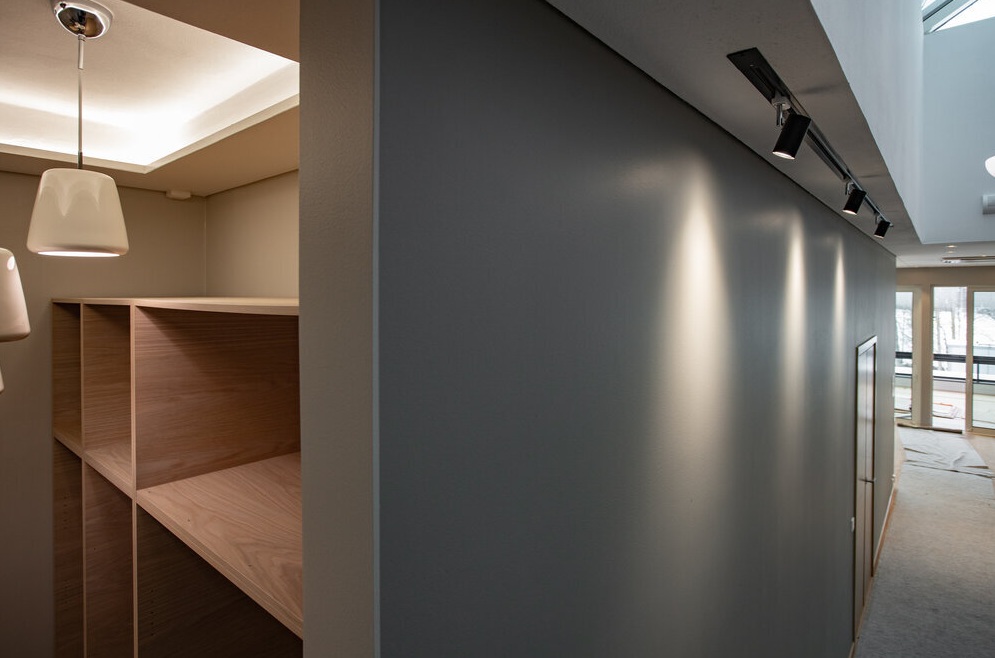Basic lighting concepts
The colour of the light matters.
The colour temperature of the light has a big influence on how the colours of the interior are reproduced. The best choice for optimal colour reproduction is to choose a light colour temperature of 4000K.
Amount of light (lm), lumen value
The lumen value (lm) tells you how much light a lamp produces in its surroundings. The higher the lumen value, the brighter the lamp. How many lumens you need to light a room depends on the size of the room and the purpose of the room. For example, for a living room of 20 square metres, a minimum of 5,000 lumens is recommended to provide enough light.
Kelvin degree (k), colour temperature of light
The degree of Kelvin defines the colour temperature of light. The higher the Kelvin value, the colder or bluer the light produced by the lamp. Which light to choose depends on your own preference and the type of interior you want to create. As a guideline, you could say that log houses at 2700K and more modern, Scandinavian interiors at 4000K. There are also luminaires available with adjustable colour temperature according to the rhythm of the day (tunable white).
2700-3000 K, warm white
The warm, incandescent light is cosy and homely, making it ideal for living areas such as the living room or bedroom. Especially in the evening before bedtime, it's a good idea to stay in warm light, as dimmer lighting prepares the body for a good night's sleep.
4000-4500 K, neutral white
Neutral white is a good general light, suitable for any space. It has a cooler tone and is also suitable for working and reading light. Choose neutral white for general lighting in a hallway, bathroom or kitchen, for example.
5000-6500 K, daylight
The colour temperature of midday sunlight is around 6000 kelvin. At this colour temperature, colours are reproduced naturally and details are clearly visible. Daylight is an excellent light for working or reading, as it reduces eye strain. It is popular with people who work with their hands, for example. Daylight is also a good make-up light.
Lux (lx), luminous intensity
The luminous intensity describes the intensity of the light source on the illuminating surface and is expressed in units of lux (lx). The luminous intensity depends, inter alia, on the luminous flux of the lamp, the optical characteristics of the luminaire and the distance from the illuminating surface. One lux is the luminous intensity of one lumen of luminous flux uniformly distributed over an area of one square metre (1 lx = 1 lm/m2). The further the surface is from the light source, the lower the luminous intensity. For example, if the intensity is 100 lux at a distance of 1 metre, it will be 25 lux at 2 metres and 4 lux at 5 metres.
Tape (cd), luminosity
The candela describes the intensity or intensity of the light source. It tells how much light is emitted at a given angle of incidence.
Colour rendering (Ra)/(CRI)
The colour rendering performance of a luminaire affects the quality of the light. It tells you how the colours of furniture and other objects will appear in the light. Colour rendering performance is described by the colour rendering index, or Ra index. The higher the number, the more naturally colours are reproduced. For domestic use, a minimum colour rendering index of Ra 80 is recommended.
Bullying behaviour (UGR)
Indicates the number of bullying handshakes from different angles. The lighting standard defines certain values for spaces that must not be exceeded. These values are based on recommendations for indoor lighting in accordance with European standard EN 12464-1.
For office premises, the URG should be 19 UGR.
The quality of lighting has a significant impact on the productivity and well-being of workers.
The light should be clear to do the job, but not blinding. The UGR value is essential in the implementation of lighting in corporate offices.


